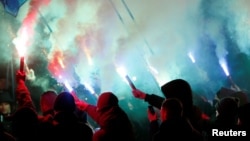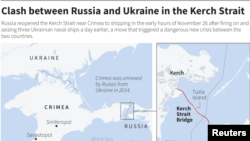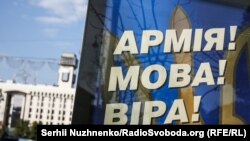A dusting of snow and unease fell over Ukraine one day after Russian Coast Guard vessels fired on and detained three Ukrainian military ships and their crews off the Crimean coast, igniting rioting outside the Russian Embassy and public demands for retaliation.
The November 25 incident marked the most significant escalation of tensions in the shared Sea of Azov this year and the first time since Russia's unrecognized annexation of Crimea four years ago that Moscow has publicly acknowledged opening fire on Ukrainian forces.
The Ukrainian General Staff of the Armed Forces was on full combat alert ahead of an extraordinary session of parliament on November 26, when lawmakers were expected to consider backing for a decree by President Petro Poroshenko to impose martial law in response to the skirmish.
Here's what went down, what has happened since, and what it all could mean:
What Happened And Where?
The Ukrainian and Russian versions of events differ, with each blaming the other for instigating the incident.
Kyiv said the Russians' actions violated a 2003 bilateral treaty designating the Sea of Azov and Kerch Strait as shared territorial waters and the UN Law of the Sea, which guarantees access through the strait.
Russian officials said the Ukrainian ships were maneuvering dangerously, requiring the strait to be temporarily closed for security reasons. Moscow has since announced the reopening of the strait after using a cargo ship to block passage beneath a controversial new bridge connecting Russia with occupied Crimea.
But what isn't disputed is that a Russian Coast Guard vessel, the Don, slammed into a Ukrainian Navy tugboat as it escorted two military vessels toward the Kerch Strait in the direction of the Ukrainian port city of Mariupol, which lies on the coast of the inland Sea of Azov. A series of dangerous events followed.
According to the Ukrainian Navy, the transfer of its vessels from the port of Odesa to the port of Mariupol was planned in advance. It said that while en route on November 25 the ships had radioed the Russian Coast Guard twice to announce their approach to the Kerch Strait but received no response.
Hours later, as the boats approached the strait, they were intercepted by Russian Coast Guard vessels. A video recorded aboard the Don and shared by Ukrainian Interior Minister Arsen Avakov appeared to show the chaos that ensued, including the moment that the Russian vessel collided with the Ukrainian tugboat. The tugboat suffered damage to its engine, hull, and guardrail, according to the Ukrainian Navy.
Ukrainian authorities said the Russian forces subsequently opened fire on its vessels, badly damaging them. Russia said its forces fired on the Ukrainian boats as a matter of security.
As the incident unfolded, Russia blocked the Kerch Strait -- the only passage to and from the inland Sea of Azov, which is jointly controlled by Russia and Ukraine -- by anchoring a freighter across the central span of its six-month-old Crimean Bridge.
At least six Ukrainian servicemen were said to have been wounded, including two seriously, a National Security and Defense Council official and a Foreign Ministry official told RFE/RL on the condition of anonymity because they were not authorized to comment officially to journalists. They said around midday on November 26 that there had been no contact with 23 sailors aboard those vessels. The ships and crew were detained and brought to the Russia-controlled port in Kerch, in annexed Crimea.
Early on November 26, Kerch FM, a local radio station and news site, published photographs and a video of what it claimed were the detained Ukrainian Navy vessels moored at the port in Kerch.
Meanwhile, Poroshenko's permanent representative for Crimea, Borys Babin, told the 112 Channel that at least three of six wounded Ukrainian servicemen had been transferred to Moscow for medical treatment. Russian Ombudswoman Tatyana Moskalkova reportedly told Ukraine's Hromadske TV that three others were being treated at a hospital in Kerch.
Poroshenko Calls For Martial Law. What Would That Mean?
From Kyiv's perspective, the sea skirmish marked a significant escalation in a long-running conflict and perhaps the opening of a new front at sea. Until then, the fighting in eastern Ukraine, where government forces have battled Russia-backed separatists since April 2014, had been mostly a land war fought in trenches and with indiscriminate heavy artillery systems, albeit with mounting confrontations at sea as Russia bolstered its military presence there.
At an emergency cabinet meeting after midnight on November 26, Poroshenko called on parliament to support a declaration of martial law to respond to Russia's attacks and its effective blockade of the Sea of Azov. His call was heeded by parliament speaker Andriy Parubiy, who convened an extraordinary session for the late afternoon.
It was unclear whether lawmakers would approve the proposal. But with a powerful coalition in parliament supporting Poroshenko, passage appeared likely. Moreover, some members of parliament who frequently oppose the coalition quickly voiced support for the measure, including Self Reliance party leader and Lviv Mayor Andriy Sadoviy.
But some lawmakers have expressed concern about the move. Mustafa Nayyem, a member of Poroshenko's party who is often critical of the president, wrote on Facebook that "the president must indicate the JUSTIFICATION of the need to impose martial law, the BORDER of the territory in which it is to be introduced, as well as the TERM for its introduction."
"In addition," Nayyem argued, "the document should contain an exhaustive list of constitutional rights and freedoms of citizens that would be temporarily restricted."
The proposal from the National Security and Defense Council that Poroshenko announced he had signed on November 26 lists some of these things. As proposed, martial law would be introduced for a period of 60 days, beginning November 26 and ending January 25, according to a text published on the president's official site.
It calls for partial mobilization, the immediate organization of air-defense forces, tightened security at borders with Russia, increased information security, an information campaign to present facts about Russia's "aggression," increased security around critical infrastructure, and more. It can reportedly be canceled at any time.
The text reportedly makes no mention of the scheduled presidential election in March, which some critics fear could be postponed. But presidential adviser Yuriy Biryukov said before the decree was published that Poroshenko's administration would not do that, adding that there would be no restrictions on freedom of speech.
Why Now?
Poroshenko and the martial law decree say it is necessary for national security. Specifically, the decree states it is "in connection with the next act of armed aggression on the part of the Russian Federation, which took place on November 25, 2018, in the Kerch Strait against the ships of the Naval Forces of the Armed Forces of Ukraine."
Beyond that, he hasn't said much else about the timing or aims.
The introduction of martial law would be an extraordinary and unprecedented move. No martial law was imposed during Russia's occupation and annexation of Crimea in early 2014 nor at any point since hostilities began a month later in eastern Ukraine -- even when Ukrainian soldiers and civilians were dying at the height of fighting that summer and in early 2015.
Back then, Ukrainian officials worried publicly that a declaration of martial law could severely damage the country's ailing economy and disrupt cooperation with the International Monetary Fund (IMF). Today, the economy has seen some recovery and the IMF recently promised Ukraine another financial bailout.
There could be other reasons, as some on Ukrainian social media pointed out after the president's proposal was made public.
Poroshenko's approval ratings have declined dramatically in recent months. He's now lagging far behind his highest-profile opponent, former Prime Minister and Fatherland party leader Yulia Tymoshenko. Some Ukrainian and foreign observers have suggested that Poroshenko, who has tried to capitalize on the threat from Russia with a three-pointed election slogan -- Army! Language! Faith! -- might benefit from playing up Russian hostilities.
Also, under martial law, he would have the legal authority to cancel or postpone elections. For its part, Ukraine's Central Election Commission reportedly stated that holding elections under martial law would be possible.
Meanwhile, in Russia, President Vladimir Putin's own approval ratings have sunk in recent months as Russians vented anger over controversial pension reforms. Putin's purported order to special forces to seize the Crimean Peninsula from Ukraine came in March 2014, with his approval ratings sagging.
But tensions in and around the Sea of Azov have been mounting for some time, with the Ukrainian military and Border Guard Service telling RFE/RL in August that it felt like only a matter of time before the situation would worsen.
How Did We Get Here?
Confrontation has been brewing in and around the Sea of Azov and Kerch Strait for months, if not years, as RFE/RL reported from Mariupol in August.
The situation began ramping up in May, when Russia opened a 19-kilometer, rail-and-highway bridge over the Kerch Strait connecting mainland Russia with the annexed Crimean Peninsula. The bridge's low height restricted the types of merchant ships that could pass, decreasing traffic to service Ukrainian ports in Mariupol and Berdyansk. For those cities, their ports are economic lifelines.
Both sides increased their military presence in the Azov region. And Kyiv accused Moscow of harassing ships bound for Mariupol and Berdyansk. Ships operated by Russia's Federal Security Service (FSB) have since detained more than 150 merchant vessels, holding them for up to several days, at considerable cost to the companies and the ports.
Each side has detained the other's vessels. In March, Ukraine's State Border Guard Service detained a Russian fishing boat and impounded it in Berdyansk. Just last week, Russian Border Guards seized a Ukrainian fishing boat and impounded it in the Russian port of Yeysk, about 60 kilometers southeast of Mariupol.
How Will The International Community Respond?
An emergency United Nations Security Council meeting has been called for later on November 26 to consider the situation.
Much of the international community, which dismissed Russia's claim to Crimea in a UN vote in 2014, has largely sided with Ukraine.
Council of Europe Secretary General Thorbjorn Jagland said free passage of the Kerch Strait was guaranteed by the 2003 treaty signed by Russia and Ukraine. "The Agreement must be respected. It is of utmost importance to avoid any further escalation in the region," he said in a statement.
Chrystia Freeland, the Canadian foreign minister, tweeted her support for Kyiv. "Canada condemns Russian aggression towards Ukraine in the Kerch Strait," she wrote. "We call on Russia to immediately de-escalate, release the captured vessels, and allow for freedom of passage. Canada is unwavering in its support for Ukraine's sovereignty."
There was no immediately statement from the White House or U.S. State Department. But U.S. Special Envoy for Ukraine Kurt Volker, who has been particularly critical of what he calls "Russian aggression" against Ukraine, tweeted, "Russia rams Ukrainian vessel peacefully traveling toward a Ukrainian port. Russia seizes ships and crew and then accuses Ukraine of provocation???"
The statements of condemnation were welcomed in Kyiv, but some Ukrainian officials privately expressed to RFE/RL their frustration with such statements. What they would prefer, they said, is for their international partners to apply fresh, harsh sanctions against Russia over the skirmish.
What's Russia's Next Move?
With Ukraine considering martial law, this is perhaps the biggest lingering question. The short answer is that no one knows.
Russia's flagship news program claimed the Kerch Strait incident was a Ukrainian provocation ordered from Washington in a bid to sabotage an upcoming meeting between President Donald Trump and Putin at this week's Group of 20 (G20) summit in Argentina.
If Russia's state media provide any indication, the Kremlin might well play up the incident as a demonstration of Ukrainian aggression and perhaps a pretext for further actions against Ukraine. But what kind of actions remains to be seen.
The Russian Foreign Ministry, in a statement, offered no specifics but warned the Kyiv "regime and its Western patrons" of "serious consequences" of the skirmish at sea.
"Clearly, this is a well-thought-out provocation that took place in a predetermined place and form and is aimed at creating another hotbed of tension in that region and a pretext for stepping up sanctions against Russia," the ministry said.
"We are hereby issuing a warning to Ukraine that Kyiv's policy, pursued in coordination with the United States and the EU, that seeks to provoke a conflict with Russia in the waters of the Sea of Azov and the Black Sea is fraught with serious consequences."
It added: "The Russian Federation will firmly curb any attempts to encroach on its sovereignty and security."






